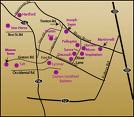How important to the wine-buying decision are American Viticultural Areas? Since 1980, when the first American Viticultural Area (AVA) was approved by the federal Bureau of Alcohol Tobacco and Firearms, now known as Alcohol and Tobacco Tax and Trade Bureau (ATT), the U.S. wine industry has been struggling with the question.
 Complicating matters even more, there is little information about whether AVAs prompt or even help a consumer select one wine over another. The narrow view holds that the only important California AVA is Napa Valley. Other more sensible consumers recognize that there are 169 other AVAs, but the question remains about the importance of all AVAs to the wine buyer and the wine producer.
Complicating matters even more, there is little information about whether AVAs prompt or even help a consumer select one wine over another. The narrow view holds that the only important California AVA is Napa Valley. Other more sensible consumers recognize that there are 169 other AVAs, but the question remains about the importance of all AVAs to the wine buyer and the wine producer.
One California winery recently told the feds that AVAs are important by requesting that one of California’s most prestigious appellations be expanded to include an area not previously known for vineyards. According to a report in the Santa Rosa Press Democrat, the E&J Gallo Winery is urging TTB to stretch the Russian River Valley AVA to include Gallo’s 350 acres of vineyards near the small Sonoma County town of Cotati, which is better known for its annual accordion festival than grape growing.
The Russian River Valley was granted AVA status in 1983, expanded twice since to now encompass about 155,000 acres, including a major change in 2005, which brought into the AVA a 400-acre vineyard owned by Kendall-Jackson. The prestigious region is best known for its Pinot Noir and Chardonnay.
Although the contested area is several miles south of the Russian River Valley, Gallo claims in its application, which includes a petition with signatures from 208 supporters, that the climate around Cotati is similar to that in the Russian River AVA.
TTB responded to Gallo’s request by opening the proposal to public comments. The issue has created a division in the Russian River Valley Winegrowers trade group, but according to the Press Democrat story, only ‘about 50 letters in opposition’ have been received.
This is more than just a trade story of one large winery’s attempt at viticultural gerrymandering; it also could mean the altering and dilution of recognized wine styles. Although Gallo has submitted research data to support its application, the jury may still be out concerning the proposed expansion of the Russian River Valley AVA. If you would like your voice to be heard on this application, the TTB public comment period is open through October 20, 2008. To enter your comment, log on to www.ttb.gov/wine/index/shtml.
6
